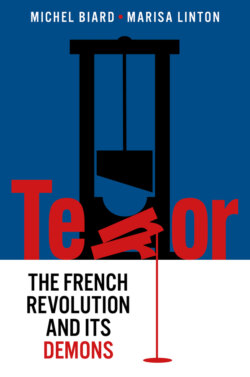Читать книгу Terror - Michel Biard - Страница 8
Foreword
ОглавлениеWe can only applaud this cross-channel collaboration between two of the most distinguished and prolific scholars of the French Revolution, the French historian Michel Biard and his British counterpart Marisa Linton. They bring together some of the most recent Revolutionary studies in both English and French for a rich and creative new synthesis. Although their study touches on aspects of the entire period from the late Old Regime through the Napoleonic period, the primary focus is on the phenomena of ‘terror’ and stateimposed violence in the years 1793 to 1794: the origins, the ongoing dynamic, the broad impact on French society and the prolonged challenge – longer than is often realized – of bringing such ‘terror’ to a close. The book also presents valuable reflections on the lengthy and contentious historiography of the phenomena in question, on debates whose origins can be traced to the writings of contemporaries of the Revolution itself and that have continued unabated into the twenty-first century.
Few periods in French history have been so afflicted by misinterpretation, deformation and facile oversimplification. The array of explanations for the phenomenon of Revolutionary ‘terror’, proposed by historians, social scientists, philosophers, literary scholars and novelists is impressive indeed. In their great majority, however, such writers had very little understanding of the actual historical reality of the events they claimed to describe and explain. The majority based their interpretations on a veritable myth concerning the years 1793–4, a myth that originated in the efforts of the post-Thermidorian Conventionnels to distance and exculpate themselves from the period of intense state repression in which they themselves were frequently complicit. ‘The Terror’ came about, they argued, through the machinations of Maximilien Robespierre and a few of his Montagnard henchmen, who sought to create a dictatorship – some even argued a new monarchy – dominated by ‘the monster’ Robespierre himself. The Terror was thus a calculated and unitary ‘system’ imposed by a small minority.
In a series of chapters organized both thematically and chronologically, the authors bring together a range of new research – including many of their own studies – to confront and demolish the ahistorical legend of 1793–4. As they make abundantly clear, the repression of those years was never conceived as a ‘system’. Most of the measures associated with the ‘terror’ were pieced together, adapted and strengthened by the National Convention over a period of several months, in response to the transforming circumstances of foreign war, civil war and popular pressure. Some had precedents dating back to the early years of the Revolution or even to the Old Regime. There was never anything approaching a single pre-conceived ideology at work in this process. And while the role of Robespierre was far from insignificant, he was by no means the dominant force as he has so often been presented. Indeed, in many cases Robespierre’s opponents, the Girondins, were at least as complicit in the creation of ‘terrorist’ institutions as were the Montagnard Jacobins.
Moreover, as the authors also make clear, it is impossible fully to understand the behaviour and political choices of the leaders of the Revolution without taking into consideration the role of emotions. On the one hand, it is important not to underestimate the extraordinary force of the joy and enthusiasm and the collective love of ‘fraternity’ as motivating factors – and the possible frustration and impatience that sometimes arose when the Revolutionaries were compelled to confront those who did not share the same enthusiasm. But to understand the repression of 1793–4, it is above all essential to examine the multiple manifestations of fear: fear of military invasion, fear of revenge, fear of traitors, fear of conspiracy: a complex of fears that might well be transformed into anger, hatred and cynical efforts at manipulation. The authors provide a graphic demonstration of the extent to which the ‘terrorists’ themselves might well feel ‘terrorized’.
To be sure, and it is to their credit, Biard and Linton are careful not to gloss over the human toll of the ‘terror’. They examine the statistics available for the executions ordered by Revolutionary tribunals and military commissions. They do not overlook the terrible repression against the Vendée rebellion and the so-called ‘Federalist’ revolts; the political ‘show trials’ against various factional opponents; and the generalized hecatomb in Paris in June and July 1794 arising from the ‘Prairial law’. They take note of the impact on the physical and mental health of those compelled to spend long months in insalubrious prisons. They meditate on the extent to which the Revolutionaries chose to set aside the Rights of Man in the face of the perceived necessity of ‘violating the law to save the law’.
But the authors also take care to contextualize all such actions in terms of both circumstances and emotions. They are impatient with the utterly inaccurate putative links between the terror phase of the Revolution and the totalitarian regimes and ideologies of the twentieth century. They underline the substantial number of exonerations and case dismissals (non-lieux), often 50 percent or higher, among those individuals brought before the Revolutionary tribunals. And they note the widely varying impact of the repression from region to region, department to department. It is clear that the most intense repression was precisely in those areas that were the scene of major armed counter-revolution against the Convention.
In conclusion, we must express our gratitude for the publication of this enormously thoughtful and nuanced study and for the authors’ efforts to come to grips with the phenomenon of French Revolutionary ‘terror’ in all its complexities and contradictions.
Timothy Tackett
